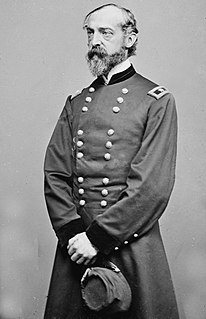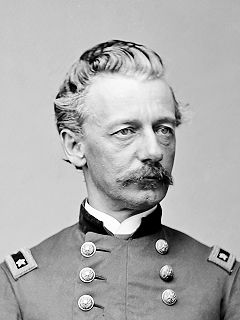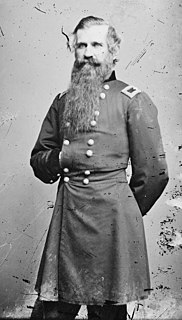Related Research Articles

George Gordon Meade was a United States Army officer and civil engineer best known for decisively defeating Confederate General Robert E. Lee at the Battle of Gettysburg in the American Civil War. He previously fought with distinction in the Second Seminole War and the Mexican–American War. During the Civil War, he served as a Union general, rising from command of a brigade to that of the Army of the Potomac. Earlier in his career, he was an engineer and was involved in the coastal construction of several lighthouses.

Winfield Scott Hancock was a United States Army officer and the Democratic nominee for President of the United States in 1880. He served with distinction in the Army for four decades, including service in the Mexican–American War and as a Union general in the American Civil War. Known to his Army colleagues as "Hancock the Superb", he was noted in particular for his personal leadership at the Battle of Gettysburg in 1863. His military service continued after the Civil War, as Hancock participated in the military Reconstruction of the South and the Army's presence at the Western frontier.

The Army of the Potomac was the principal Union Army in the Eastern Theater of the American Civil War. It was created in July 1861 shortly after the First Battle of Bull Run and was disbanded in June 1865 following the surrender of the Confederate Army of Northern Virginia in April.

Irvin McDowell was a career American army officer. He is best known for his defeat in the First Battle of Bull Run, the first large-scale battle of the American Civil War. In 1862, he was given command of the I Corps of the Army of the Potomac. He fought unsuccessfully against P.G.T. Beauregard's troops during the Valley Campaign of 1862, and was blamed for contributing to the defeat of United States troops at the Second Battle of Bull Run in August.

Oliver Otis Howard was a career United States Army officer and a Union general in the American Civil War. As a brigade commander in the Army of the Potomac, Howard lost his right arm while leading his men against Confederate forces at the Battle of Fair Oaks/Seven Pines in June 1862, an action which later earned him the Medal of Honor. As a corps commander, he suffered two major defeats at Chancellorsville and Gettysburg in May and July 1863, but recovered from the setbacks as a successful corps and later army commander in the Western Theater.

Alfred Howe Terry was a Union general in the American Civil War and the military commander of the Dakota Territory from 1866 to 1869 and again from 1872 to 1886. In 1865, Terry led Union troops to victory at the Second Battle of Fort Fisher in North Carolina.
Department is an organizational term used by the U.S. Army, mostly prior to World War I, to describe named geographical districts created for control and administration of installations and units. In 1920, most of the named departments were redesignated as numbered Corps Areas. However, the Hawaiian, Panama Canal, and Philippine Departments retained their old names. In 1939, the Puerto Rican Department was created and in May 1941 the Panama Canal and Puerto Rican Departments were combined as the Caribbean Defense Command, although each was still referred to as a department.

Henry Warner Slocum, Sr., was a Union general during the American Civil War and later served in the United States House of Representatives from New York. During the war, he was one of the youngest major generals in the Army and fought numerous major battles in the Eastern Theater and in Georgia and the Carolinas. While commanding a regiment, a brigade, a division, and a corps in the Army of the Potomac, he saw action at First Bull Run, the Peninsula Campaign, South Mountain, Antietam, Chancellorsville, and Harpers' Ferry.

John Newton was a career engineer officer in the United States Army, a Union general in the American Civil War, and Chief of the Corps of Engineers.

John Cleveland Robinson had a long and distinguished career in the United States Army, fighting in numerous wars and culminating his career as a Union Army brigadier general of volunteers and brevet major general of volunteers in the American Civil War. In 1866, President Andrew Johnson nominated and the U.S. Senate confirmed Robinson's appointment to the brevet grade of major general in the regular army. He was a recipient of the Medal of Honor for valor in action in 1864 near Spotsylvania Courthouse, Virginia, where he lost a leg. When he retired from the U.S. Army on May 6, 1869, he was placed on the retired list as a full rank major general, USA. After his army service, he was Lieutenant Governor of New York from 1873 to 1874 and served two terms as the president of the Grand Army of the Republic.
The Department of the Missouri was a command echelon of the United States Army in the 19th century and a sub division of the Military Division of the Missouri that functioned through the Indian Wars.
A subdivision of the Division of the Missouri, the Department of Dakota was established by the United States Army on August 11, 1866, to encompass all military activities and forts within Minnesota, Dakota Territory and Montana Territory. The Department of Dakota was initially headquartered at Fort Snelling, Minnesota, and then moved to St.Paul in March 1867. The 18th Infantry Regiment would serve in Dakota several times. From 1869-1877 the 20th Infantry Regiment was posted to the Department. In 1879 the Department returned to the Fort until 1886 at which time moved back to downtown St. Paul. The department was discontinued in 1911.

The Department of California was an administrative department of the United States Army. The Department was created in 1858, replacing the original Department of the Pacific, and it was ended by the reorganizations of the Henry L. Stimson Plan implemented in February 1913. As with the preceding organization, headquarters were in San Francisco. Its creation was authorized by General Orders, No. 10, of the War Department, Adjutant-General's Office, September 13, 1858.
The Military Division of the Pacific was a major command (Department) of the United States Army during the late 19th century.
The Department of the East was a military administrative district established by the U.S. Army several times in its history. The first was from 1853 to 1861, the second Department of the East, from 1863 to 1873, and the last from 1877 to 1913.
Military Division of the South was a U. S. Army unit established in 1869 during the period of Reconstruction.
The Military Division of the Missouri was an administrative formation of the United States Army that functioned through the end of the American Civil War and the Indian Wars that continued after its conclusion. It was created by the War Department on February 3, 1865, at the direction of General Ulysses S. Grant to bring all the military departments west of the Mississippi River under a single commander.
Department of Washington, was a department of the Union Army constituted on April 9, 1861. It consisted of the District of Columbia to its original boundaries, and the State of Maryland as far as Bladensburg. It was merged into the Military Division of the Potomac on July 25, 1861. Later it was recreated on February 2, 1863 as the consolidated Department of Washington and XXII Corps. It was again made the Department of Washington in 1865 and that command remained until 1869 when it was disbanded.
The Department of the South was a military department of the United States Army that existed in several iterations in the 19th century during and after the American Civil War.
The Military Division of the James was an administrative division or formation of the United States Army which existed for ten weeks at the end of the American Civil War. This military division controlled military operations between April 19, 1865 and June 27, 1865 in parts of Virginia and North Carolina under control of two main Union armies, the Army of the Potomac and the Army of the James.
References
- U.S. Army Order of Battle 1919–1941, Volume 1. The Arms: Major Commands and Infantry Organizations(chapter 2)
- National Archives, Guide to Federal Records; Records of United States Army Continental Commands, 1821-1920 (Record Group 393), 1817-1940 (bulk 1817-1920)